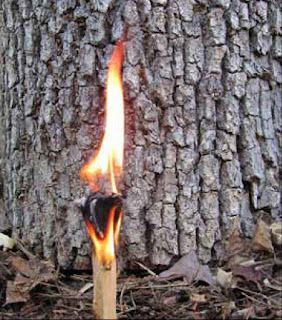Trail Foraging – Pine Trees: Last month I mentioned the antiseptic uses of pine trees and that got me thinking about whole bunch of new topics for trekking tips. Some of the things I am familiar with; some I am not. This will be an educational journey for all of us!
As these articles come along, I highly recommend getting a
book on foraging for your area. My sister bought me a great one for Texas that
I used extensively. You should be able to find a regional guide and yes, take
it trekking and use it! The people we emulate knew herbal and foraging uses
because it was an everyday survival need for them. Their knowledge of wild
plants is no different than our knowledge of using a computer or smart phone.
So don’t be ashamed to carry and break out that guidebook!
Pine trees have many uses: fire starter, first aid, herbal supplement, glue, and skin salve. A use for glue, I have tried it before by mixing charcoal from a fire and mixed with melted pine pitch. I have seen many flint nappers use it to attach arrow heads and you can use it to patch tent holes, bull boat holes and many other items. (1 part charcoal to 3 parts pine resin)
As an antiseptic pine sap has natural antibacterial
properties and can be used to help seal wounds. Sap oozing from damaged
coniferous tree is always readily available or you can melt down hardened globs
of pitch or resin to create a medical superglue. Also, pine sap contains
vitamin C, which boosts your immunity against bacteria and infection.
As a fire starter we are all familiar with “fat lighter”, and you could cover a stick in sap to make a torch or for building a fire. You can dip pinecones into melted sap and let it harden for later use especially in wet weather.
As an herbal supplement pine is used quite often. Pine tree sap
and needles have nutrients and antibacterial properties and can be used as
anti-inflammatory teas and broths for treating a sore throat or other issues.
Pine can be used for upper and lower respiratory tract swelling,
stuffy nose, hoarseness, common cold, cough or bronchitis, fevers, and blood
pressure problems. Some people apply pine directly to the skin for mild muscle
pain and nerve pain.
Native American tribes would eat the inner bark of the white
pine as a food source when other food was scarce. The Iroquois, here in my
region, would use the resin mixed with beeswax to seal their canoes. Other
Native Americans would boil the bark and then apply the liquid to their wounds.
Take some time and do some research on pine trees, you will be
astounded. See you around a fire! Looking forward to The Battle of Camden in November!
Written by Gerry "Lucky" Messmer. Reprinted with permission from the author.
Code: glm01


